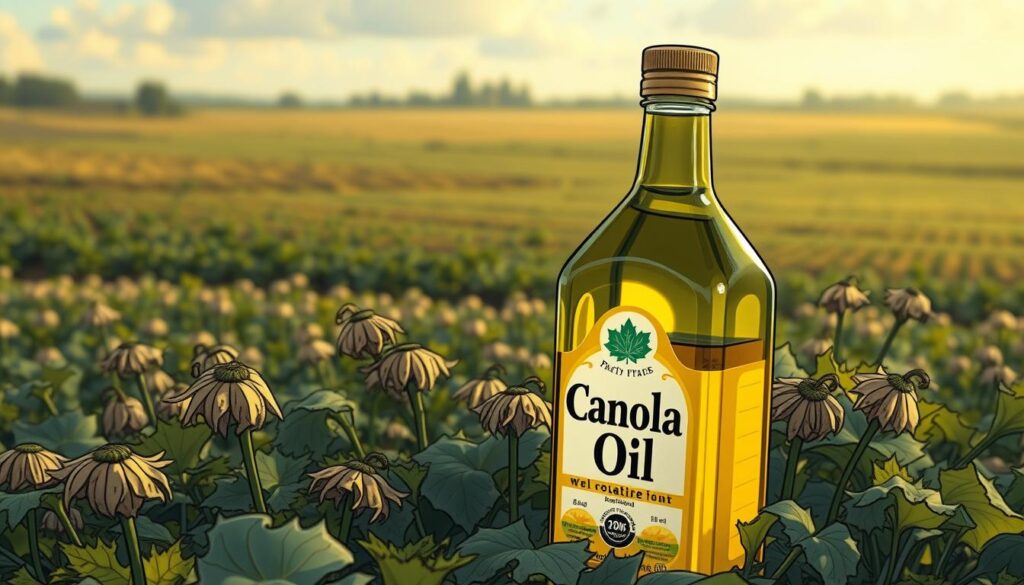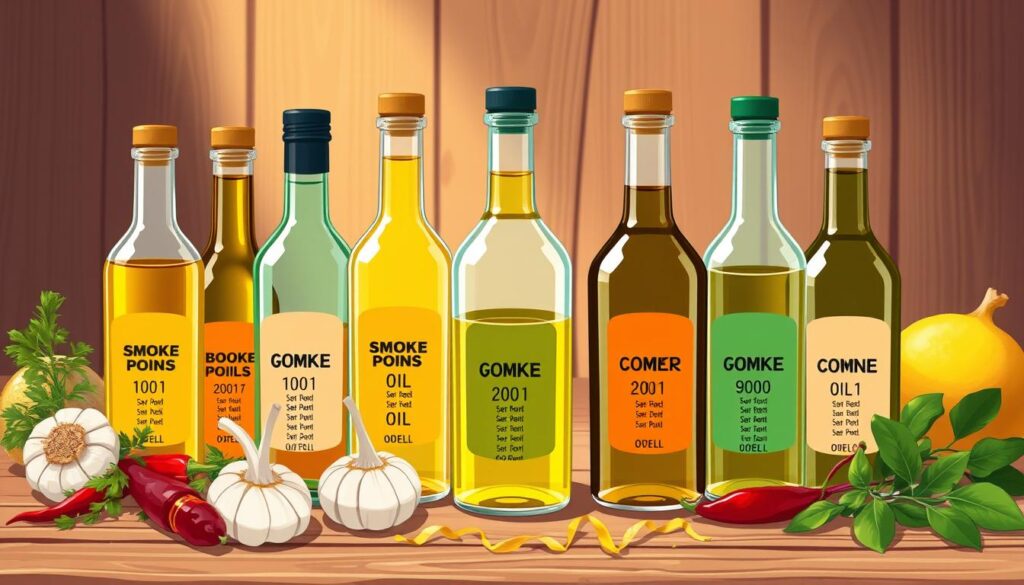Olive oil is a favorite in many kitchens. But it’s not always the best choice for every recipe or diet. Luckily, there are healthy oil alternatives that can replace olive oil. Each has its own special qualities and benefits.
Table of Contents
ToggleWe’ll look at five such oils in this guide. You’ll learn about their origins, what they’re good for, and how to use them in cooking.
Maybe you want to try new recipes, save money, or follow a special diet. Knowing about these olive oil substitutes can make cooking healthier and more fun. Let’s explore the oils that can be your new go-to.
Understanding Fats and Oils
To get the most from different oils, knowing about fats and oils is key. All oils and fats are made of triglycerides. These are molecules with three fatty acid chains and a glycerol backbone.
Chemical Structure of Fats and Oils
Fatty acids are split into saturated, monounsaturated, or polyunsaturated types. Saturated fats have no double bonds. Unsaturated fats, like monounsaturated and polyunsaturated, have one or more double bonds.
The “omega” number shows where these double bonds are. This tells us if a fatty acid is omega-3, omega-6, or omega-9.
Types of Fatty Acids
Knowing about fats and oils helps us see their health and cooking benefits. Here’s a brief look at the main fatty acid types:
- Saturated fats: Found in foods like butter, cheese, and red meat. They have no double bonds in their chemical structure.
- Unsaturated fats:
- Monounsaturated fats: Found in olive oil, avocados, and nuts. They have one double bond.
- Polyunsaturated fats: Found in vegetable oils, nuts, and fatty fish. They have multiple double bonds.
The type and amount of fatty acids in an oil affect its nutrition and cooking use. Knowing these differences helps us pick the best oil for us.
Introducing Canola Oil
Origins and History of Canola
Canola oil comes from the rapeseed plant. This plant is part of the brassica family, which includes cabbage and broccoli. Rapeseed oil has been used for food and other purposes for centuries in Eurasia.
In the 1970s, people started to worry about its high erucic acid. Canadian researchers then created a new rapeseed variety with less erucic acid. They called it “canola oil” to make it sound better.
Now, canola oil is seen as a healthy choice. It has a good taste and is great for cooking and baking.

The creation of low-erucic acid rapeseed, or LEAR oil, was a big step. It made rapeseed into a popular cooking oil. This change helped canola oil become widely used and loved today.
Health Benefits of Canola Oil
Canola oil is known for its health benefits. It has a lot of monounsaturated fatty acids (MUFAs) and omega-3 fatty acids. These are good for you.
Using canola oil instead of other fats can lower heart disease risk. It does this by improving cholesterol and reducing inflammation. The omega-3 to omega-6 fatty acid ratio in canola oil also helps your heart and metabolism.
Canola oil has less saturated fat than other oils. This makes it better for your heart. With only 1 gram of saturated fat per tablespoon, it’s great for keeping cholesterol levels healthy.
- Canola oil is rich in monounsaturated fats, which can help lower “bad” LDL cholesterol and raise “good” HDL cholesterol.
- The omega-3 fatty acids in canola oil, such as alpha-linolenic acid (ALA), have anti-inflammatory properties and may help protect against cardiovascular disease.
- Canola oil is a good source of vitamin E, an antioxidant that can help protect cells from damage and support a healthy immune system.
While canola oil is good for you, the quality matters. Choose a high-quality, minimally processed canola oil. This way, you get the most benefits from this versatile oil.
Olive Oil Alternatives
Olive oil is loved by many, but there are great alternatives. Canola oil is one such option. It has a similar amount of monounsaturated fats as olive oil. Plus, it has good amounts of omega-3 and omega-6 fatty acids.
The Nutritional Profile of Canola Oil
Canola oil has less saturated fat than olive oil. This makes it better for your heart. It has about 60% monounsaturated fats, 30% polyunsaturated fats, and only 10% saturated fats.
This mix of fats can help lower cholesterol and heart disease risk. Canola oil also tastes neutral. This means it won’t take over the flavors in your dishes.
Canola oil can handle high heat, unlike olive oil. It’s great for stir-frying, searing, and sautéing. This makes it very useful in many recipes.

Cooking with Canola Oil
Canola oil is a top pick for cooking. It has a high smoke point of 400-450°F (204-232°C). This makes it perfect for stir-frying, sautéing, and baking.
Its neutral taste lets other flavors stand out. This is true for both savory and sweet dishes.
Canola oil is also good for frying because it has less saturated fat. It’s a healthier choice than oils with more saturated fats. This makes it a great substitute for olive oil in many recipes.
Canola oil is great for making stir-fries, sautéing veggies, or baking treats. It’s reliable and healthy. Its high heat tolerance and neutral taste make it versatile for many dishes.
Potential Drawbacks of Canola Oil
Canola oil is often seen as a healthy choice. Yet, there are some things to watch out for. In the past, rapeseed oil had too much erucic acid, which was bad for animals. But today’s canola oil has very little erucic acid, making it safe for us.
Some worry about genetically modified (GM) canola. A lot of canola is made to resist drought and pests better. If you don’t like GM foods, look for organic or non-GMO canola oil.
The FDA says canola oil is safe since 1985. GM plants are also okay to eat. But, some people still choose to avoid GM foods.
Also, making canola oil can remove some good stuff. For more nutrients, choose expeller-pressed or cold-pressed canola oil.
Erucic Acid and GMO Concerns
- Canola oil has only 2% erucic acid, unlike rapeseed oil’s 43%. It’s safe for us.
- GM canola plants are better at fighting drought and pests. They’re still safe to eat.
- If you don’t like GM foods, find organic or non-GMO canola oil.

Other Healthy Oil Options
Canola oil is great, but there are other healthy oils too. These oils can replace olive oil in your cooking. They fit different tastes and diets.
Olive oil is loved for its good fats and taste. Eating a bit of olive oil each day can protect your heart. It also keeps healthy compounds safe because it’s made without harsh methods.
Avocado oil is another top pick. It has a high smoke point and lots of nutrients. It may help fight cancer and Alzheimer’s, and lower cholesterol.
Coconut oil is popular, but it’s mostly saturated fat. Eating too much can be bad. So, don’t eat too much of it, about 6% of your daily calories.
Sunflower oil and peanut oil are also good. Sunflower oil has lots of good fats. Peanut oil is great for cooking at high heat. Each oil has special benefits, so choose wisely.
Using different healthy oils can make your meals more interesting. You’ll get a variety of nutrients and flavors. It’s a smart way to eat well.
Tips for Choosing the Right Oil
Choosing the right oil for cooking is key. It affects the taste, nutrition, and how well your dishes turn out. Two important things to think about are smoke point and stability.
Smoke Points and Stability
The smoke point is when oil starts to smoke and break down. Oils like canola and avocado oil have high smoke points. They’re good for cooking at high heat, like searing and stir-frying.
Oils with low smoke points, like extra virgin olive oil, are best for lower heat or for making salad dressings. They’re not as good for high heat.
Stability is also key. Some oils can go bad quickly, losing their good taste and nutrients. Choosing cooking oils that stay stable, like refined oils, helps keep your food tasting great.
- High smoke point oils (like canola and avocado) are great for high heat cooking.
- Low smoke point oils (like extra virgin olive oil) are better for cold versus hot applications.
- Consider oil stability to maintain flavor and nutritional value.

Knowing about smoke points and stability helps you pick the best oils for your cooking. This way, you can make dishes that taste great and are good for you.
Incorporating Healthy Oils into Your Diet
Adding healthy oils like canola oil to your meals is easy and good for you. Use canola oil instead of oils with bad fats for cooking. It’s great for sautéing, baking, and even frying.
Canola oil also tastes good in both savory and sweet dishes. It’s a good choice because it doesn’t change the taste of your food much.
Healthy oils are not just for cooking. They’re also good in salad dressings and as a finishing touch on food. It’s key to store oils right to keep them fresh. Choosing the right oils can make your food healthier and tastier.
- Try different healthy oils like avocado, sesame, or peanut oil in your cooking.
- Use canola oil instead of bad fats when cooking.
- Drizzle healthy oils on veggies, salads, or other dishes for extra flavor and nutrition.
- Keep oils in a cool, dark spot to keep them fresh and good.
Using a variety of healthy oils in your meals can make your food better and healthier. It helps support your health too.
Conclusion
Olive oil is not the only good choice for cooking. This article looked at five other oils, focusing on canola oil. It showed how these oils can replace olive oil in many recipes.
Knowing about fats and oils helps you choose better. You can pick oils that are good for your heart, reduce inflammation, or just add flavor to your food. There are many tasty and healthy oils you can use instead of olive oil.
Adding healthy oils to your meals is easy and good for you. By learning about canola oil and other options, you can make your diet better. This way, you can enjoy food that’s good for you and tastes great.
FAQ
What are the key differences between various types of fatty acids?
Fatty acids are divided into saturated, monounsaturated, and polyunsaturated types. Saturated fats have no double bonds. Unsaturated fats, like monounsaturated and polyunsaturated, have one or more double bonds.
The position of these double bonds is key. It tells us if the fatty acid is omega-3, omega-6, or omega-9.
What is the history and origin of canola oil?
Canola oil comes from the rapeseed plant. It has been used for food and other purposes for centuries in Eurasia. But in the 1970s, rapeseed oil got a bad name because of its high erucic acid.
Canadian researchers then created a new rapeseed variety with much less erucic acid. This new oil was called “canola oil” to make it sound better.
What are the health benefits of canola oil?
Canola oil is good for you because it’s full of monounsaturated fatty acids (MUFAs) and omega-3 fatty acids. Studies show it can lower the risk of heart disease by improving cholesterol and reducing inflammation.
It also has a good balance of omega-3 to omega-6 fatty acids. This balance is good for your heart and metabolism.
How does the nutritional profile of canola oil compare to olive oil?
Canola oil has less saturated fat than olive oil. It also has a higher smoke point, making it better for more cooking methods. Plus, it has a good mix of polyunsaturated fats, including omega-3 and omega-6.
What are the potential drawbacks of using canola oil?
Older rapeseed oil had too much erucic acid, which was bad for animals. But today’s canola oil has very little erucic acid, making it safe for people.
Some worry about genetically modified (GM) canola. But most canola is not GM. If you want non-GM, look for organic or non-GMO verified canola oil.
What other healthy oil options can substitute for olive oil?
Other healthy oils include olive oil, avocado oil, coconut oil, sunflower oil, and peanut oil. Each has its own benefits and uses.
What factors should I consider when choosing a cooking oil?
When picking a cooking oil, think about its smoke point and stability. The smoke point is when an oil starts to smoke and taste bad. Stability is important because some oils can go rancid, losing their good qualities.
How can I incorporate healthy oils, like canola oil, into my diet?
Adding healthy oils like canola oil to your diet is easy and good for you. Use canola oil instead of other oils when cooking. It’s great for sautéing, baking, and even frying.
Canola oil’s mild taste makes it good for both savory and sweet dishes. You can also use it in salad dressings, marinades, and as a finishing touch on food.
Source Links

This article is medically reviewed by Dr. Chandril Chugh, Board-Certified Neurologist, providing expert insights and reliable health information.
Dr. Chandril Chugh is a U.S.-trained neurologist with over a decade of experience. Known for his compassionate care, he specializes in treating neurological conditions such as migraines, epilepsy, and Parkinson’s disease. Dr. Chugh is highly regarded for his patient-centered approach and dedication to providing personalized care.








